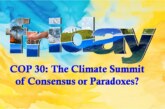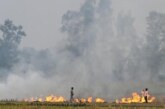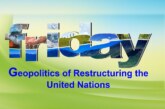United Nations Convention to Combat Desertification (UNCCD)
| As water is the most disruptive element in the ongoing climate crisis, how land is managed plays a major role in taming this disruption. This publication shows that avoiding, reducing and reversing land degradation can have positive long-term gains in water security. – Adriana Erthal Abdenur -Climate diplomacy.org |

Water scarcity is a worldwide problem with higher levels of scarcity experienced in areas which has low natural water availability, high levels of irrigated agriculture or high population density relative to water availability. Around 36% of the world’s population is currently living in water-scarce regions, and a 2018 global study on water for drinking, cooking and sanitation from the United Nations concluded that water shortages could affect 5 billion people by 2050.
Land degradation, Drought, Water scarcity, Water management; water use efficiency, Water security, monitoring, financing, Sustainable Development Goals
Rising temperatures and increasing variability in precipitation patterns have caused water scarcity around the world. This leads to major negative implications, both globally and nationally and across multiple economic sectors. Worldwide, the agricultural sector, which accounts for two-thirds of global water usage, is most affected by droughts which caused socio-economic impacts. Water scarcity and recurring droughts also lead to negative environmental impacts, such as reduced biodiversity and ecosystem services and higher greenhouse gas emissions from wetlands and other water systems. Land degradation and water scarcity are closely linked.
| Water scarcity is found in nearly every region in the world, with higher levels of scarcity experienced in areas with low natural water availability (such as arid and semi-arid regions), high levels of irrigated agriculture or high population density relative to water availability |
Land Degradation Neutrality (LDN) is an integral part of SDG 15 and is incorporated in target 15.3, which aims to “combat desertification, restore degraded land and soil, including land affected by desertification, drought and floods, and strive to achieve a land degradation-neutral world” by 2030.LDN provides a supporting framework to manage both land and water resources sustainably at the landscape level, address the challenge of water insecurity and drought and provide opportunities for policy and operational synergies within the land-water nexus.
Countries have come to realise the importance of land and water management and the benefits of sustainable development. To ensure that countries reach their LDN objectives, improve synergies between LDN, water security and drought mitigation and achieve the SDGs through LDN approaches, the following recommendations are provided for countries-
- Continue to mainstream the land-water linkage into relevant national policies and strategies
- Establish and build national capacities in the monitoring of water resources, including wetlands
- Implement land and water conservation approaches and taking water management decisions at the appropriate level
- Improve water-use efficiency by using all available methods for all uses
- Ensure the interaction between the national focal points for the three Rio Conventions
- Further incorporate LDN policies and integrated land and water strategies during the next review of the UNFCCC Nationally Determined Contributions.
- Explore climate funding as an essential source of funding, complemented with national funding sources

The study assesses the water-related LDN approaches countries aim to use to achieve LDN, which for the purposes of this study have been grouped under five categories and 15 sub-categories:
- Integrated land and water management through:
- A landscape approach at watershed level;
- Soil and water conservation practices;
- Mitigation of coastal erosion and coastal management
- Improved management of water resources through:
- Enhanced water harvesting;
- Expansion of irrigated areas;
- Monitoring of water resources
- Increased water-use efficiency through:
- Use of water-saving irrigation techniques;
- Other water-saving measures for agricultural and drinking water;
- Wastewater reuse;
- An enabling environment including:
- Legislation and national policies;
- Institutional set-up;
- Financing strategies;
- Measures related to wetlands and aquatic ecosystems:
- Wetland conservation or restoration;
- Protection against run-off or pollution;
- Sustainable use of wetlands and wetland productivity.
Healthy land has a natural capacity to store and filter water, but this capacity is lost when land is degraded. Similarly, land-use changes, such as the conversion of wetlands and forests to other land uses, disrupt the water cycle and hydrological functions. Conversely, water scarcity and droughts can accelerate the processes of land degradation, for instance due to poor irrigation management and drainage and altered hydrology, leading to poorer quality soils. To combat drought and achieve long-term water security, it is therefore necessary to manage and preserve both land and water resources.
Download full report from the website:
References of work:
https://olc.worldbank.org/content/land-degradation-neutrality-water-security-and-combatting-drought
chrome-extension://oemmndcbldboiebfnladdacbdfmadadm/http://www.fao.org/3/ca7468en/CA7468EN.pdf



